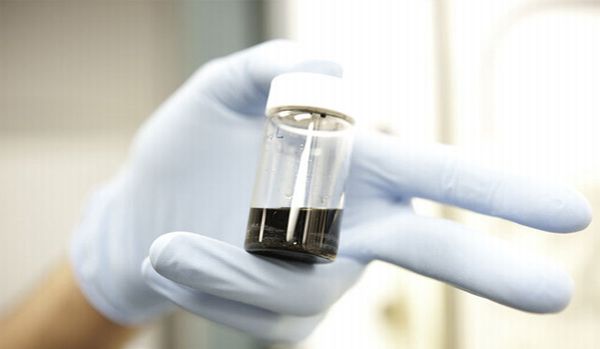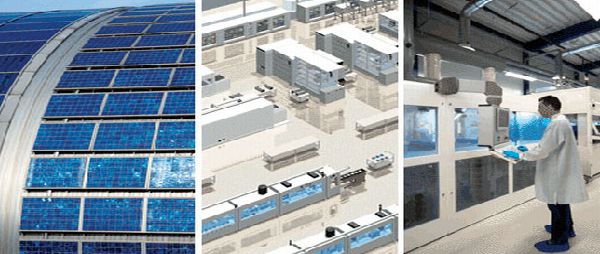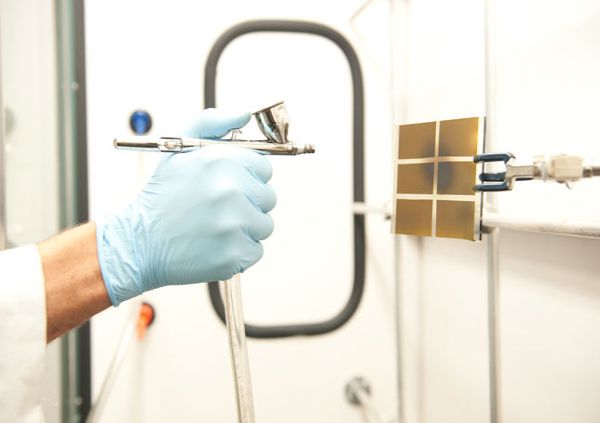
Ever thought that the unlimited energy source provided by the sun can be used as a paint like a spray-on tan? Well, here it is called the spray-on solar cells. According to a chemical engineer, “Solar cells soon could be painted onto the sides of buildings or rooftops with nanoparticle inks.” Brian Korgel at the University of Texas at Austin stated that,
”The new-nano ink process could replace the standard method of manufacturing solar cells, which requires high temperatures and is relatively expensive.”
It is also known as photovoltaic cells which helps in direct conversion of sunlight into electricity. The materials involved in making it are silicon and some others that can easily absorb steam. These cells can be used in the form of solar panels, which are used to provide electricity for homes and industries. Each of these panels contain about 40 cells as told by the National Renewable Energy Laboratory. The ink used for the spray is developed by Korgel’s team, which consists of sunlight-absorbing nanoparticles called copper indium gallium selenide (CIGS) which is 10,000 times thinner than hair strand. Such inks can be printed on newspapers now. The substrate can be a bit flexible or even made out of plastic or a metal foil which could not be rolled. The nanocrystal shaped cells would be sprayed on the paper for printing.The entire process of the solar spray is on a conveyor belt, which will include a hydrogen film which is antireflective.
Trends:
Spray-on solar cells can provide green electricity for microscopic machines:

These cells have a capability to power extremely small sized machines since they are just 1 mm long. One can customize the spraying in an ecofriendly manner. As a matter of fact, the researchers at the University of South Florida have stated that these cells can be sprayed on any place that is exposed to the sunlight. Organic polymer has given birth to such one millimeter long cells, which are easily diluted and ready to be printed on a material that’s adjustable enough. An array of 20 such cells have been able to produce electricity of nearly 8 V, which is used to provide power to sensors that are as tiny as nanotubes. At the same they are used for sniffing dangerous chemicals and sensors.
Spray-on solar factory to be the largest photovoltaic plant in Southern hemisphere:

A new energy system which is photovoltaic in nature has been developed by Spark Solar. The minister for infrastructure, Anthony Albanese, says “the solar manufacturing facility has the potential to be the largest supplier of solar cells in the Southern hemisphere.The factory site is still under finalizing terms. Currently, the set up has been planned in various locations which are under consideration like Adelaide, Geelong, Wollongong, Queanbeyan, and Canberra. The first solar cells were already released by the end of 2010. More than 10 million solar cells are considered to run the annual productions with an estimation of $135 million AUD as annual export revenues. Employment purpose has also been taken into account for more than 115 Australians at top tech positions. The Major Project Facilitation status by the government is to be granted first to “The Spark Solar”, Australia’s solar cell manufacturing project, which has been given access to government programs and approvals.
Spray-on solar cell offers window of opportunity for green buildings:

A team of scientists have come up with a plan to commercialize spray-on solar cells that can be used on aircrafts and buildings. Ensol, a Norwegian company along with some scientists announced at the University of Leicester a new thin-film photovoltaic cell that can be successfully painted onto surfaces that are flat. The proposed technology has already been tested and will be hopefully able to have a cell efficiency of 20 percent by 2016 before becoming commercial. It is a thin-film coated material as well as transparent, which proves to be better than some existing technologies.
Spray-on solar cells printed like newspaper:

As discussed before, nanoparticle inks can serve to paint walls of buildings or rooftops. Basically, to reach the commercial market, these cells have to achieve an efficiency level of upto 10 percent but it’s still at 1 percent.
The benefits:
There couldn’t have been a better cut-throat competition in the market for technology serving as a paint. A cloudy day also cannot hamper the process because it is capable of fetching the infrared rays from the sun.The fact that this solar material can be used as a spray-on paint to help in generation of portable electricity is another advantage. The composite material can be sprayed on like paint, and then used to generate highly portable electricity. Now, energy can be created using both infrared as well as visible light using this material.
Effectively, recharging batteries on a continuous level can be done using a vehicle that is coated with this material. A new material, with the help of infrared, can give out power five times more than the current plastic solar cells which means only 6% of the sun’s energy to needed to create sufficient electricity.
The drawbacks:
Cleaning of solar painted walls or rooftops would require sometime as the efficiency depends on absorption of sunlight. The lab is still making it feasible for people to use this technology inside the houses. However, the testing of the new spray-on photovoltaic cell is still in progress at the Australian National University. It is expected to finish by the end of 2011. Cost effectiveness is the the biggest challenge here. The worldwide economy has tightened up budgets for everyone along with the electrical industries. Hence, an investment in the research of solar energy would be expensive.
The impact:
Australia has definitely proved to take this on a positive note since a three-year project has been developed by a couple of researchers to use spray-on solar panels, which are more efficient and less costly than the current photo voltaic cell. Spark solar Australia and Finnish materials have been helping out the Australian National University in making this commercially available by 2011 as reported by G-Online. The experiment under different surfaces is still going on to improve the efficiency of these solar cells.




